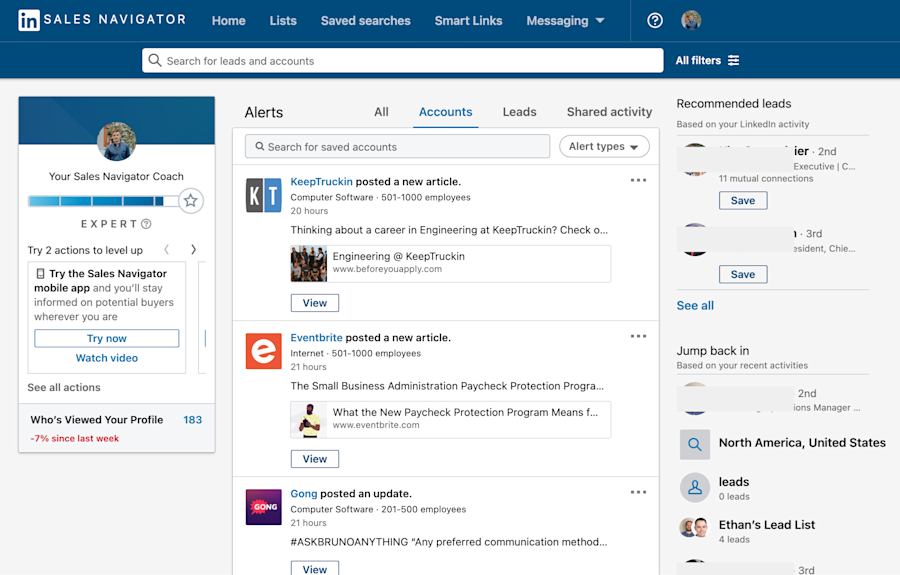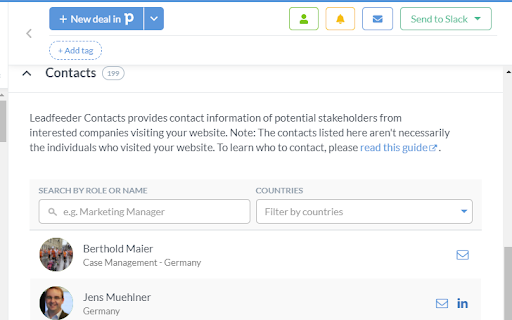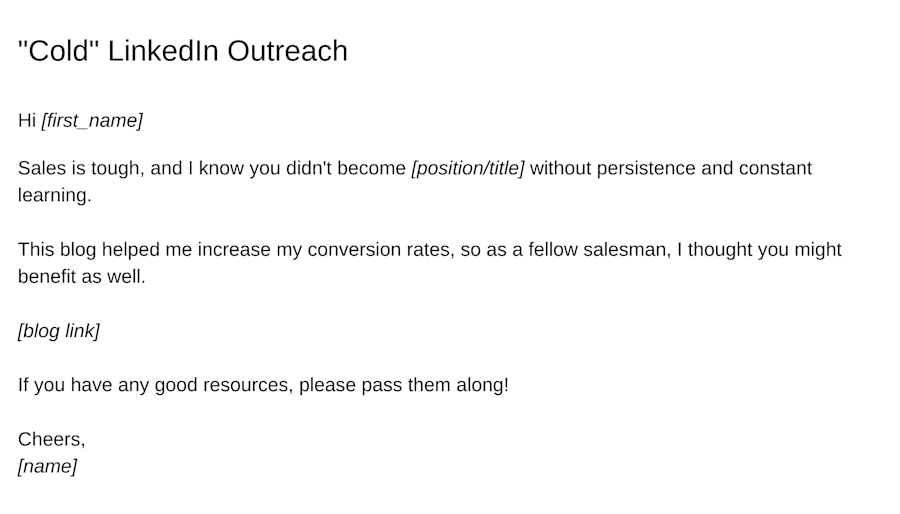Most sales tactics are terrible. hey are either overly generic (“Focus on better leads!”) or completely useless for selling in a post-COVID world (“Invite them out for lunch!”). Give me something that I can actually work with!
If you are tired of reading about the same boring sales tactics, then you’re in the right place.
The truth is, what works in sales hasn't changed much in recent years. Sales is still about building relationships — and it always has been.
What has changed is how we communicate.
Tech like social media, AI, sales prospecting software, and online video conferencing has drastically changed how we communicate and sell.
It's time to make sure your sales strategies are keeping up with the times.
Note: If you’re looking for warm leads, website visitors certainly qualify. Try Leadfeeder’s 14-day free trial to see what companies are behind your traffic.
What are sales tactics? (and why you should bother)
Sales tactics are any strategy you use to deliver a compelling message to prospects. This includes everything from deciding which leads to pursue to crafting a personalized email follow-up.
You're thinking, I've been in sales for a while. I've got a lock on how to connect with my customers.

Maybe you did before COVID.
The world has changed. Online meetings are the norm. Businesses are relying more on software and less on people to complete tasks like data entry and analysis.
In some cases, sales teams have gotten so reliant on software that they miss the human aspect entirely.
So, what is the solution? How do you connect with prospects authentically when in-person meetings are limited, and budgets are tight?
8 sales lead tips to close deals
Most prospects head to their friends or a search engine when they need a solution.
So, where does that leave your sales process?
Rather than starting from scratch, sales teams need to take a hard look at how they communicate and who they talk to.
Let's look at eight sales lead tips that will help you close deals in 2025 and beyond.
1. Leverage buyer intent data
Tired of cold calling? Me, too.
Cold calling might be one of the oldest sales strategies out there, but it's dying. True cold calling — where you pick up the phone and call someone off a list with no prior interaction — is ineffective, annoying, and has an incredibly low ROI.
So, what's the solution? Buyer intent data.
Buyer intent data shows you who has visited your website, what pages they read, and where they clicked. That data can help inform your outreach.
For example, you might see that three people from the same company viewed information about the social media tool you offer. That tells you the company is likely looking for a social media tool.
Buyer intent tools like Leadfeeder can track these leads and even send them over to your CRM. Instead of cold calling, you reach out to a curated list of prospects that have expressed an intent to buy.

2. Use Sales Navigator to target the right leads
Prospecting with Sales Navigator is the bees' knees. It’s a sales feature on LinkedIn used to reach the right customers — an excellent tool for social selling because of its advanced search and follow features.
For example, you can quickly build a lead list with the “Lead Builder” feature using keywords, job title, location, and other filters. When you’ve saved those people as leads, you’ll see all of their updates and behavior on your Sales Navigator home page.
Sales Navigator serves as a window into what your prospects are doing.
After you’ve created your Sales Navigator lead list, you can follow their activity on your timeline at an individual or company level if you follow multiple people from the same company.
This provides excellent insights into what is happening on a company level — so you can comment or start a discussion based on relevant events.

The good news is that if you haven’t tested any of LinkedIn’s premium features, there's a 14-day free trial available. If you work in sales or marketing and are actively looking for new business opportunities, it’s worth the investment.
3. Find the right contact person
You know a company is interested in what you have to offer, you've gathered some info about the company, and you've crafted the perfect pitch.
Now it's time to reach out — but who do you contact? If you're selling a sales tool, you wouldn't want to reach out to the marketing team, right?
Finding the right contact person can drastically shorten the sales cycle, so it's important to get it right.
To find the right contacts, you can use LinkedIn, Google the company to find out more information, or simply poke around the company's website.
To use the LinkedIn approach, search the company and click on the “Contacts” link or click through to LinkedIn to directly search for people working at the target company.
Leadfeeder also provides location and contact information data for your feed, helping narrow down your options.
The “Contact” section (shown below) provides contact information from potential stakeholders, including their email and LinkedIn in many cases. If you already know someone from the company, it’s easy to contact them and ask for an introduction to the key decision-maker.

If you use Pipedrive, Salesforce, or Zoho CRM, Leadfeeder can send leads directly to your sales pipeline. This improves the follow-up process because your activities and the company’s visits to your website are stored and displayed in one place.
4. Warm-up cold leads
Before you pick up the phone — or type out that email — make sure you fully understand who your prospect is and what drives them.
Warming up cold lead helps your pitch stand out because you understand their needs, but it also prevents you from wasting time on prospects that are unlikely to convert.
Use sales prospecting information to understand who your lead is and what they might need.
For example, what pages have they read on your site? Has their company recently gone public or launched a new product you can help with?
Then, check out their LinkedIn profile, their Twitter, and find out what they are into. You might find you share an affinity for Chicago pizza or loathe the same football team. That information gives you a place to start.
5. Use video to connect
Most people prefer in-person communication. This is because we make snap-second judgments about whether to trust someone based on their facial features and body language.
Unfortunately, that isn't always an option today. Your clients may be thousands of miles away — and remote work enforces the distance even further.
Video can fill the in-person gap and help you build relationships with prospects.
Video lets you connect in a personalized, expressive manner. People can see your face, and your body language — and watching a video allows you to share more information in far less time.
It might feel awkward to send a video, but it can be an incredibly effective sales tactic. Here are a few times sending a personalized video can make all the difference:
Use video during outreach to break through inbox clutter.
Create personalized demos that speak to your customer's needs.
Use video to follow up after a call and mention specific concerns.
Reduce back and forth emails (or calls) by explaining proposals.
Re-engage prospects that have gone dark with friendly video.
6. Know what to say
When you contact leads, base the conversation or pitch around what they read or searched for on your website. Just don't say you saw they visited your site — it isn't particularly relevant to your pitch and can come across as a little creepy. 😬
Below are some scripts and templates to try. Feel free to adjust them to fit your company or personality.
Sales email template #1
“Hi [prospect], My name is [first_name], and I work at a company called Leadfeeder. We help thousands of companies get more sales leads by identifying unknown website visitors that would otherwise go unnoticed.
We already work with ‘[reference A]’ and ‘[reference B]’ and would you be interested in having a quick chat in the coming days about how we could practically help you increase your sales and get more qualified leads for your sales team?”
Sales email template #2
“Hi [prospect], We periodically reach out to companies who show interest in XYZ product/service. This is a courtesy email to see if you have any questions about XYZ. Do you have a few minutes to chat this week? In the meantime, I thought you might find this article/link interesting.”
Track the opens/clicks of the emails you send using tools like Banantang. Once you notice they have shown further interest in your email, you can schedule the next follow-up – and remember, timing is everything.
Sales pitch script #1
In this case, we have seen that based on their web behavior, this lead is looking for information about lead generation tools and is checking out our blog for lead generation tips:
“Hi, this is John Doe calling from Leadfeeder. We help thousands of companies worldwide get more sales leads by identifying unknown website visitors that normally go unnoticed.
We already help company A and company B to get more sales leads from their digital channels. Do you have time to have a quick chat next Tuesday about how we could help your company get more qualified leads and better sales opportunities?”
Sales pitch script #2
In another case, a lead was looking for email marketing tips and reading our blog post called “How to write a follow-up sales email that doesn’t suck”.
“Hi, this is [first_name] calling from Leadfeeder. Our solution, Leadfeeder, can help you to get more sales leads and clear ROI from your email marketing campaigns by identifying your website visitors and how they behave on your website.
I could give you some ideas on how to get more qualified sales leads from your email marketing. Do you have time to meet next Thursday afternoon?”
7. Build a personal brand
Keeping a low profile used to be the norm for salespeople — after all, it's marketing's job to pull in the prospects, right? You are just there to close the deal.

Times have changed, and a lot of salespeople are dropping the ball. Building a personal brand establishes you as a trustworthy, reliable source of information — who just happens to sell.
Everything you do on social media boils down to building your personal brand and expertise.
Make sure your LinkedIn profile is built to showcase your sales expertise and how you can help people in your industry. Use relevant keywords in your description and an engaging cover photo. Also, join and engage in groups your target audience is likely to frequent.
Build credibility and perfect your ability to stand out from the crowd by creating content that helps your target prospects solve problems and offer resources and advice even when you aren't trying to make a sale. Brand awareness, baby.
Remember, the average B2B prospect will research on their own before they are ready to buy. Make sure your profile showcases how you can help.
8. Offer help, not just a pitch
If you have done the first steps well, you’ll notice that investing time in building a personal brand and social selling are critical, especially with enterprise-level prospects. Helping is the core of building relationships that lead to sales.
As a sales rep, you have to provide value and help upfront, even before you have your audience in your sales pipeline. Dipak offered up his go-to LinkedIn outreach template:

Knowledge is just a short Google search away -- only salespeople who provide more value than Google will win.
Once you establish trust with a prospect and know who you are and how you can help them, it’s easier to start the real sales process.
If you know your prospect and know your solution can actually help them, you can gradually move the sales process to “offline” channels like email or even by setting up a meeting.
So, how do you do that?
Survey your target audience to find out their pain points, then offer solutions.
Ask prospects what their challenges are, then address how your solution can help.
Answer questions and engage in industry Facebook and LinkedIn groups.
Above all, don't be pushy. Pay attention to their body language (if you use video conferences) and tone and know when to walk away.
Start using your new sales tactics
When it comes to sales tactics, the more things change, the more things stay the same. If you aren't leveraging tools like buyer intent data, personal branding, and video, you’re leaving money on the table.
Note: Want to see which companies are looking at your website? Try Leadfeeder free for 14 days to uncover prospects using buyer intent data.
Now that you're here
Leadfeeder is a tool that shows you companies that visit your website. Leadfeeder generates new leads, offers insight on your customers and can help you increase your marketing ROI.
If you liked this blog post, you'll probably love Leadfeeder, too.
Sign up






